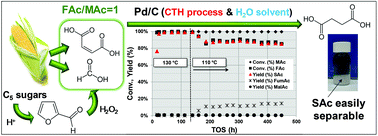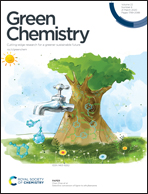Catalytic transfer hydrogenation of maleic acid with stoichiometric amounts of formic acid in aqueous phase: paving the way for more sustainable succinic acid production†
Abstract
The aqueous phase hydrogenation of maleic acid (MAc) to succinic acid (SAc) is demonstrated in the absence of any organic solvent and using stoichiometric amount of formic acid (FAc) as source of H2. Among the different noble metals (Pd, Au, Ru, Pt and Rh) and supports investigated (γ-Al2O3, TiO2, CeO2, ZrO2, WO3, CeZrO4, carbon, nicanite, SiO2 and TS-1), Pd/C was identified as the best catalyst. We observe that the undesirable formation of malic acid (MalAc) by hydration of MAc must be prevented. The transformation of MAc to SAc with negligible formation of MalAc is possible by using relatively mild temperature (140–150 °C) and a high catalyst to MAc ratio (i.e. fixed bed continuous flow reactor). Using the carboxylate forms (disodium maleate and sodium formate) instead of the acids results in an increase of the reaction rate. In a fixed bed reactor under a continuous flow of 15 wt% of MAc at a WHSV = 12 h−1 (contact time = 5 min), at 150 °C, 10 bar of N2 and using a formic acid/maleic acid molar ratio = 1, a yield of SAc close to 98% was obtained, equivalent to a productivity of 1.87 g SAc per gcat per·h. Leaching of Pd was below 0.02 ppm. No deactivation was observed in long term experiments at 150 °C (ca. 730 h), although the characterization of the used catalyst by CO chemisorption and TEM and XPS studies showed certain sintering of Pd particles. Regarding the mechanism of the reaction, kinetic isotopic experiments using deuterated DCOOH indicated that the reaction must essentially proceed via catalytic transfer hydrogenation, formyl H of formic acid is involved in the rate determining step of the reaction. When using maleate and formate sodium salts, the second H needed for the reaction is supplied by the solvent (H2O molecules). A preliminary environmental assessment (Life Cycle Analysis, LCA) of this CTH approach indicates that for relevant environmental categories of the LCA (such as climate change and consumption of fossil resources) the CTH process is greener than conventional hydrogenation process; the benefits are even larger if biomass-derived FAc is involved.



 Please wait while we load your content...
Please wait while we load your content...